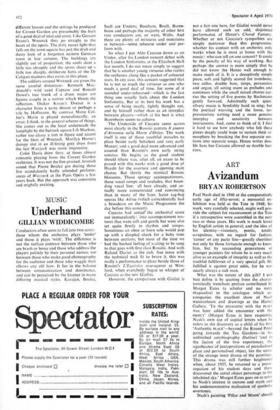ART
Avizandum
BRYAN ROBERTSON
Paul Nash died in 1946 at the comparatively early age of fifty-seven; a memorial ex- hibition was held at the Tate in 1948; his work, very carefully selected, might well pro- vide the subject for reassessment at the Tate if a retrospective were assembled in the next two or three years. His work is much loved by English artists in general; and the idea of his identity—visionary, poetic, totally scrupulous, with no regard for fashion. `career' or any party line—greatly cherished not only by those fortunate enough to knoss, him, but by succeeding generations of younger painters for whom he is very much alive as an example of integrity as well as the truthful fulfiknerit of a very special gift. He fulfilled it against great odds, for he was nearly always a sick man.
What was the nature of this gift? I can best define it by quoting from the charac- teristically trenchant preface contributed by Margot Eates (a scholar and no mere rhapsodist) to the catalogue which ac- companies the excellent show of Nash watercolours and drawings at the Hamet Gallery. To the encounter with the PLACI, was later added the encounter with the OBJECT' (Margot Eates is here respecting Nash's own use of capital letters when he refers to the discovery as a child of his first `Authentic PLACE'—beyond the Round Pond going towards the Tea Gardens—in his unfinished autobiography Outline) 'and in the fusion of the two experiences, the significance of juxtapositions of personalised place and personalised object, lies the secret of the strange inner drama of the paintings. This drama was still further heightened when, about 1937, he returned to a preoc- cupation of his student days and there discovered the aerial object personage in the inhabited sky.' Margot Eates goes on to refer to Nash's interest in custom and myth and his undemonstrative realisation of symbolic overtones.
Nash's painting 'Pillar and Moon' should be as familiar, as an image; to the English as The Cardinal', 'Stuffing the Goose', 'Mine Host' (three popular bestsellers by anonymous hands) or, at a loftier altitude, Hobbema's 'Avenue of Poplars', since 'Pillar and Moon' was issued as a commercial reproduction at some point in the late 1930s and could be seen, framed in light oak, in the corridors of almost any school in the coun4 try. The print also confronted one from the windows of 'art shops' from Balham to Aberdeen, along with the works of Holbein, Vermeer, Miss Billie Waters, and those more expensive reproductions of what seemed to be naked young charladies, with discon- certingly boy-like figures glistening with vaseline, scrubbing the floors of vast ateliers, by Russell Flint. Later, to add to what I feel must surely be a popular identity, Paul Nash became known to an even wider public through his wartime painting of twisted and contorted crashed aircraft, flung together in an otherwise deserted field, which he called with justifiable spleen 'lodes Meer' (Dead Sea). Nash was a war artist in two world wars as well as the illustrator of Urne-buriall and Blake's Thiel among much else. He was at his best, however, when the human figure was eliminated from his paintings or draw- ings; and his metaphysical sense (which made such a delicate structure for the 'Mansions of the Dead', in which weird bird forms perch, against an ice-blue sky, on the thin poles of a cosmic bird cage) can already be detected at work in the splendid watercolour of girders and joists in 'St Pan- cras and Fairground Skeleton', shown at the Hemet Gallery.
My warmest reactions to Nash are aroused by the 'Sunset Eye study 2' (1944.5) in which the red-peach-green-gold radiance of Turner is set into a formal coherence of which Cezanne would have approved; but the study is truly celestial, of the sky, with nothing earthbound to mar the abstract discipline. Elsewhere, he seems to have found a mystical partage de midi of his own in the queer limbo of the 'Atlantic crossing' series of drawings and paintings, among which the small vertical pencil 'Study for Atlantic' (1932) is a notably refined but structurally firm example: the essence of hauntedly empty ship-bound existence.
The stage was set by Nash when he painted the equally haunting 'Winter Sea' canvas in his early years: there are several versions, I believe, but the one I think of is at the Graves Art Gallery, Sheffield (where John Hoyland grew up, admiring this particular work) and the taut, sombre pain- ting in overlapping rectangular planes of white, ivory, cream; warm and cold browns, grey and black, receding into a bleak eternity is one of the most resoundingly felt and ex- perienced abstract paintings, of absolute originality, by any English artist. The Hamet Gallery show gives a very decent indication of Nash's peculiar imagination; but it is only a token show, with rather an inevitable emphasis on more straightforward if no less delightful examples of topography in Lon- don or the country. We must see more, as soon as possible: for English abstract art before 1939 was not solely in the hands of Nicholson, Moore and Hepworth, as the developing myth would have us believe. There is much else to discover and there was more than one kind of abstraction, pace Merlyn Evans, David Jones, Frances Hodgkins, Roy de Maistre, and several others. History must not be trimmed to con- form to our present notion of style: we can- not afford to discard or leave in oblivion such gifted artists,



































 Previous page
Previous page